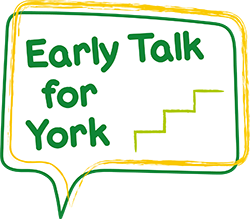
Early Talk for York is an approach to improve speech, language and communication of children aged 0 to 5 years.
Getting involved in our 3-step Early Talk for York programme will demonstrate your continued commitment to improving the speech, language and communication skills of children.
You'll be joining many practitioners already following the approach and help bring consistency across the early years sector.
View our Early Talk for York roadmap to see all aspects of Early Talk for York. This is a great starting point for thinking about the opportunities available and how you can get involved with each aspect.
Our Early Talk for York roadmap overview will help you see how it all fits together.
We're inviting early years settings and childminders to submit an expression of interest form to access funded opportunities to get involved in the Early Talk for York 3-step approach.
You can use and display our Early Talk for York resources to promote and celebrate your involvement.
The Early Talk for York approach is also supported by other partners working in the sector. Collaborating with these partners will help improve outcomes for children and may also help with pressures on your team.
Contact the Early Talk for York team with any questions and for more information about getting involved.
Depending on whether you work in a group based early years setting (school, nursery, pre school, and so on) or as a childminder, the approach is slightly different. Please choose the approach that is correct for you to see further details:
Also see
Early Talk for York
Children's Services


